Effect of the Internal Humidity of Concrete on Frost Resistance and Air Void Structure under Different Low Temperature Conditions
Abstract
:1. Introduction
2. Materials and Methods
2.1. Raw Materials
2.2. Concrete Mix Proportion
2.3. Methods
3. Results and Discussion
3.1. Concrete Properties and Internal Moisture Content
3.2. Mass Loss and Dynamic Elastic Modulus Change
3.3. Air Void Parameters
4. Conclusions
Author Contributions
Funding
Acknowledgments
Conflicts of Interest
References
- Mehta, P.K. Concrete: Microstructure, Properties, and Materials; McGraw-Hill Press: New York City, NY, USA, 2016. [Google Scholar]
- Ministry of Water Resources of the People’s Republic of China, National Bureau of Statistics of the People’s Republic of China. First National Water Census Bulletin; China Water and Power Press: Beijing, China, 2013.
- Setzer, M.; Auberg, R.; Keck, H.J. Frost resistance of concrete: From nano-structure and pore solution to macroscopic behaviour and testing. In Proceedings of the International RILEM Workshop, Essen, Germany, 18–19 April 2002; pp. 18–19. [Google Scholar]
- Sun, Z.; Scherer, G.W. Pore size and shape in mortar by thermoporometry. Cem. Concr. Res. 2010, 40, 740–751. [Google Scholar] [CrossRef]
- Fagerlund, G. The Significance of Critical Degrees of Saturation at Freezing of Porous and Brittle Materials; Durability of concrete; American Concrete Institute: Detroit, MI, USA, 1975; pp. 13–65. [Google Scholar]
- Powers, T.C. The Mechanisms of Frost Action in Concrete (Durability of Concrete, SP-8); ACI: Detroit, MI, USA, 1965; pp. 42–47. [Google Scholar]
- Powers, T.C.; Willis, T.F. The air requirement of frost resistant concrete. Highw. Res. Board Proc. 1949, 29, 183–211. [Google Scholar]
- Gao, P.; Lu, X. Microstrueture and pore structure of concrete mixed with superfine phosphorous slag and superplasticizer. Constr. Build. Mater. 2008, 22, 837–840. [Google Scholar] [CrossRef]
- Scherer, G.W. Crystallization in pores. Cem. Concr. Res. 1999, 29, 1347–1358. [Google Scholar] [CrossRef]
- Scherer, G.W. Stress from crystallization of salt. Cem. Concr. Res. 2004, 34, 1613–1624. [Google Scholar] [CrossRef]
- Rostasy, F.S.; Schneider, U.; Wiedeman, G. Behavior of mortar and concrete at extremely low temperatures. Cem. Concr. Res. 1979, 9, 365–376. [Google Scholar] [CrossRef]
- Liu, Z.; Hansen, W.; Wang, F.; Zhang, W. Simulation of air-void system in hardened concrete using a geometrical model. Mag. Concr. Res. 2019, 13, 680–689. [Google Scholar] [CrossRef]
- Zhao, T.; Zhu, J.; Feng, N. Analysis of pore characterization parameters in concrete. In Symposium on Six Decades of Work on Science and Education of Academician Wu Zhongwei; China Building Materials Industry Press: Beijing, China, 2004; pp. 99–102. [Google Scholar]
- Ojala, T.; Chen, Y.; Punkki, J.; Al-Neshawy, F. Characteristics of Entrained Air Voids in Hardened Concrete with the Method of Digital Image Analysis Coupled with Schwartz-Saltykov Conversion. Materials 2021, 14, 2439–2443. [Google Scholar] [CrossRef]
- Zhang, P.; Liu, G.; Pang, C.; Yan, X.; Qin, H. Influence of pore structures on the frost resistance of concrete. Mag. Concr. Res. 2017, 69, 271–279. [Google Scholar] [CrossRef]
- Zheng, Y.X.; Yang, P.; Kang, H. The overview of concrete structure durability under the freeze-thaw condition. J. Zhengzhou Univ. (Eng. Sci.) 2016, 37, 27–32. [Google Scholar]
- Ma, K.; Wang, Z.; Long, G.; Xie, Y.; Zeng, X. Propagation and Evolution of Macroscopic Crack of Concrete Under Dynamic Load-Water-Freeze-Thaw Action: A Review. Mater. Rep. 2021, 35, 19091–19098. [Google Scholar]
- Xie, R.F.; Lu, L.J.; Qiao, P.Z. Study on micromechanical property deterioration in the interface transition zone of ultra-high performance concrete under the action of freeze-thaw cycles. Chin. Sci. Tech. Sci. 2018, 48, 1092–1102. [Google Scholar]
- Su, H.; Xie, W. Review on Frost Damages of Hydraulic Concrete in Cold Region and Its Preventive Control. Bull. Chin. Ceram. Soc. 2021, 40, 1053–1071. [Google Scholar]
- Lu, C.; Ge, X.; Mei, G. Effect of air void parameters on frost resistance of hydraulic concrete. Mater. Res. Innov. 2015, 9, 389–392. [Google Scholar]
- Ge, X.; Lu, C.; Mei, G. Mechanical and frost resistance properties of high air content hydraulic concrete. Mater. Res. Innov. 2015, 19, 510–513. [Google Scholar]
- Ge, X.; Lu, C.; Mei, G. Research on effect of cooling rate on concrete freezing stress and its mechanism. Mater. Rep. 2020, 34, 8051–8057. [Google Scholar]
- Li, X.; Fu, Z.; Luo, Z. Effect of atmospheric pressure air content and air void parameters of concrete. Mag. Concr. Res. 2015, 67, 391–400. [Google Scholar] [CrossRef]
- Liu, S.; Wang, Z.; Li, X. Long-term properties of concrete containing ground granulated blast furnace slag and steel slag. Mag. Concr. Res. 2014, 66, 1095–1103. [Google Scholar] [CrossRef]
- Yang, H.; Zhou, S.; Su, J. Effect of air void parameters on properties of air entraining concrete. Water Power 2009, 35, 18–19. [Google Scholar]
- Yuan, J.; Wu, Y.; Zhang, J. Characterization of air voids and frost resistance of concrete based on industrial computerized tomographical technology. Constr. Build. Mater. 2018, 168, 975–983. [Google Scholar] [CrossRef]
- Shon, C.S.; Abdigaliyev, A.; Bagitova, S.; Chung, C.W.; Kim, D. Determination of air-void system and modified frost resistance number for freeze-thaw resistance evaluation of ternary blended concrete made of ordinary Portland cement/silica fume/class F fly ash. Cold Reg. Sci. Technol. 2018, 155, 127–136. [Google Scholar] [CrossRef]
- Hasholt, M.T. Air void structure and frost resistance: A challenge to Powers’ spacing factor. Mater. Struct. 2014, 47, 911–923. [Google Scholar] [CrossRef] [Green Version]
- Jin, S.; Zhang, J.; Huang, B. Fractal analysis of effect of air void on freeze–thaw resistance of concrete. Constr. Build. Mater. 2013, 47, 126–130. [Google Scholar] [CrossRef]
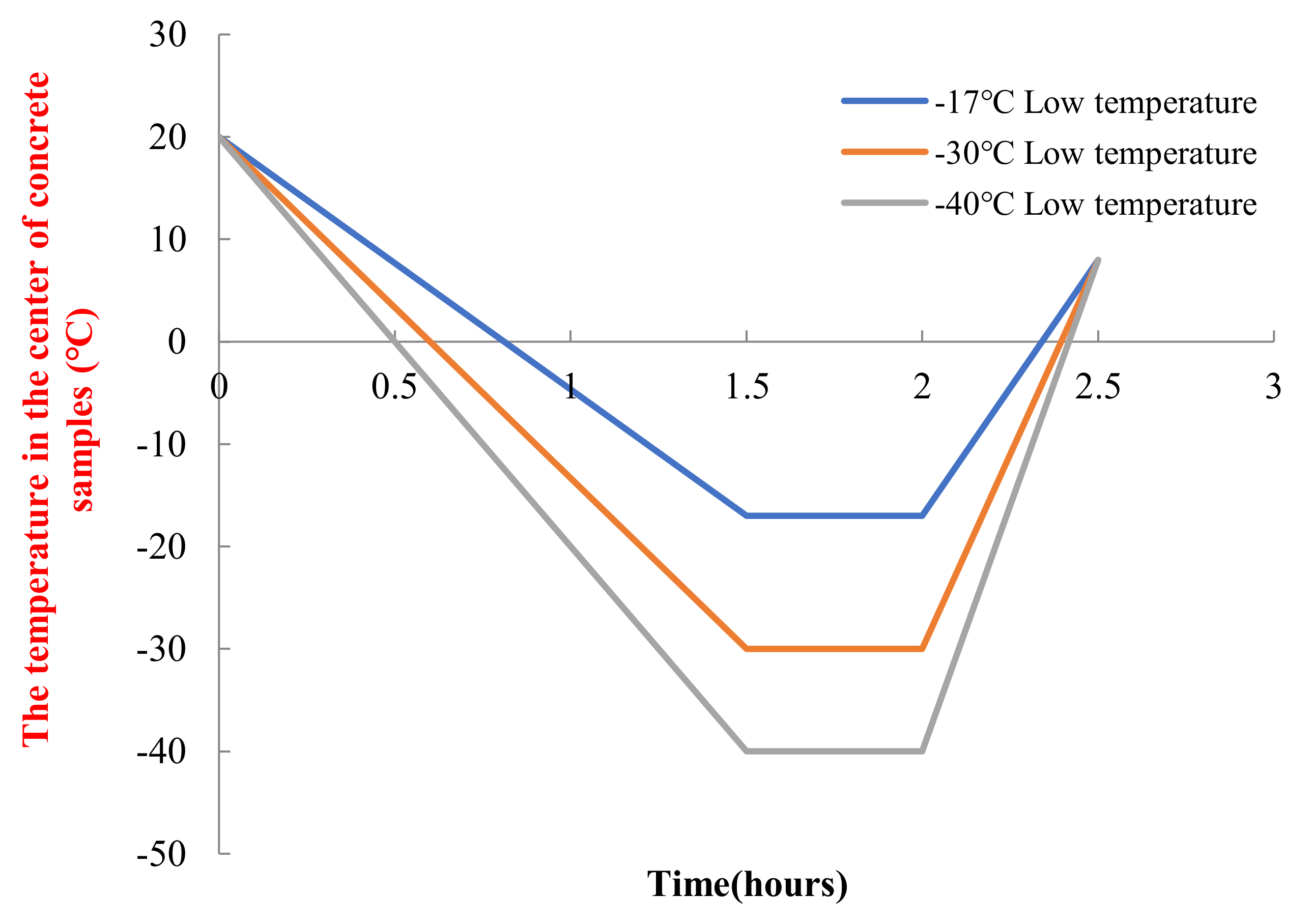
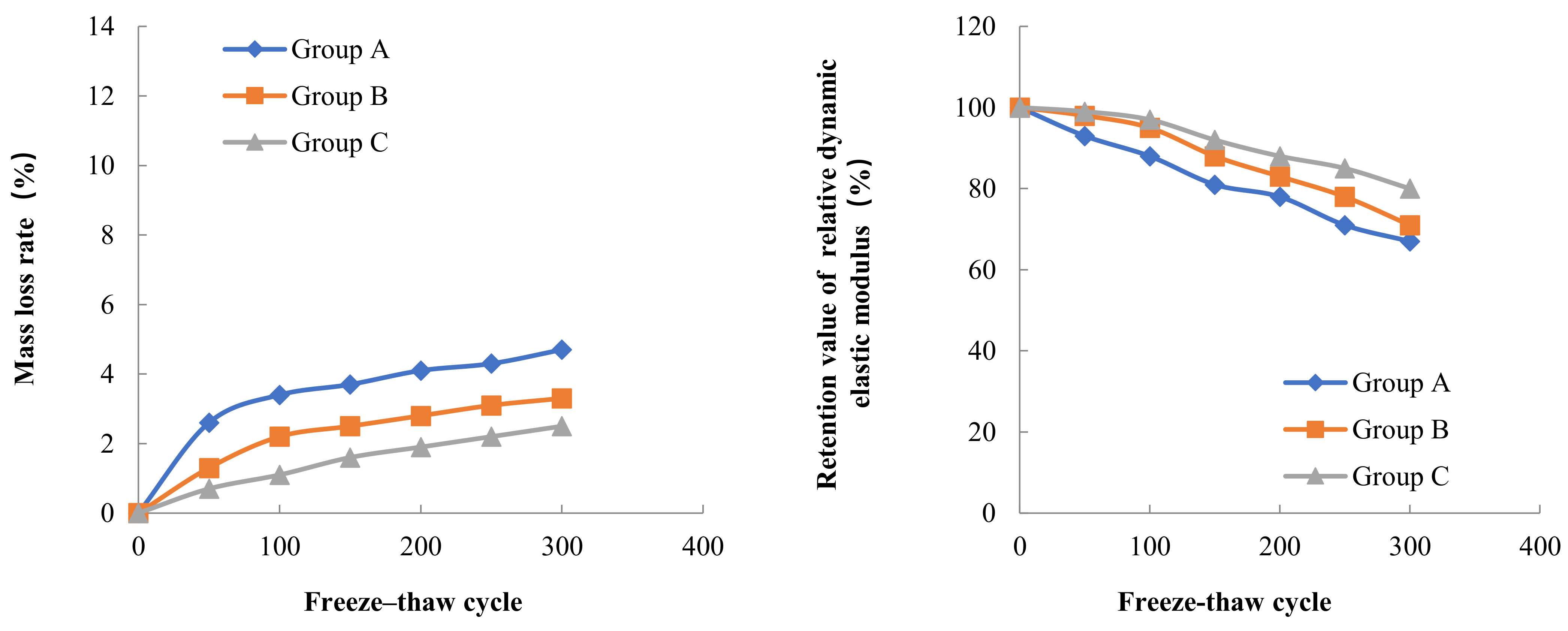

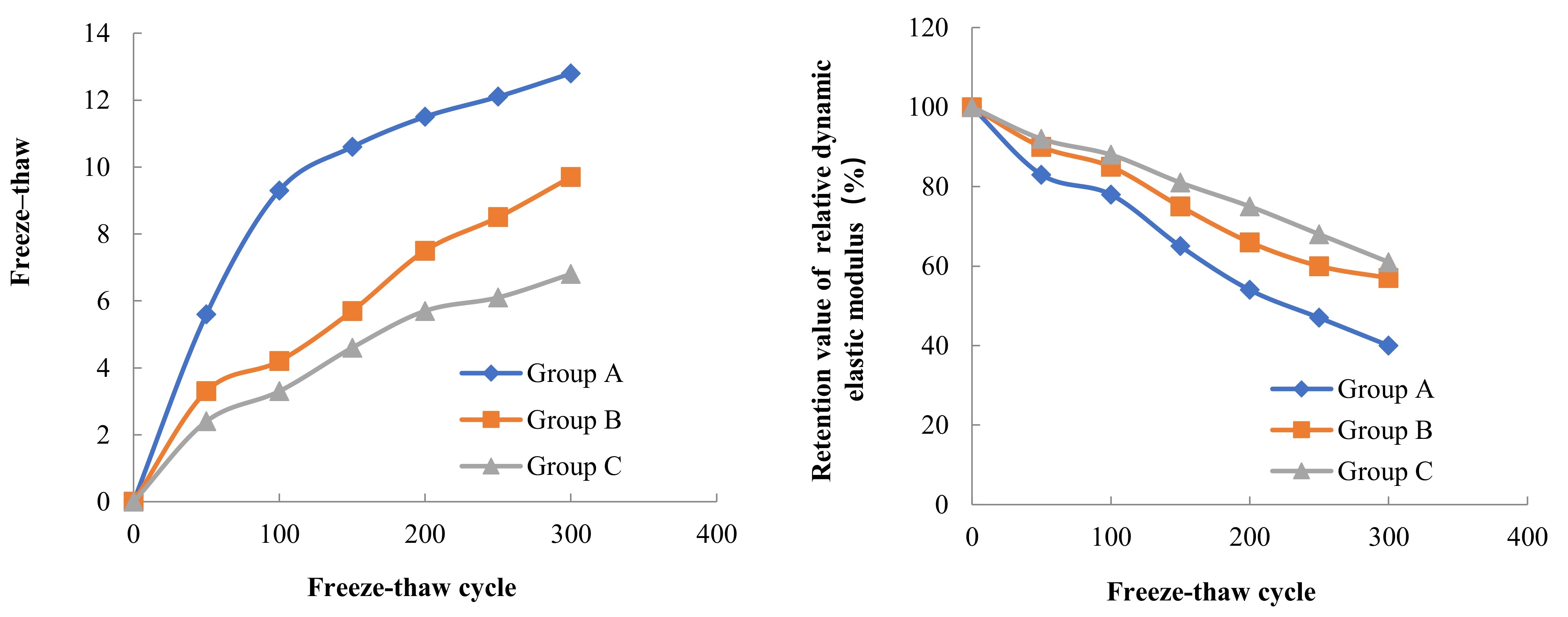
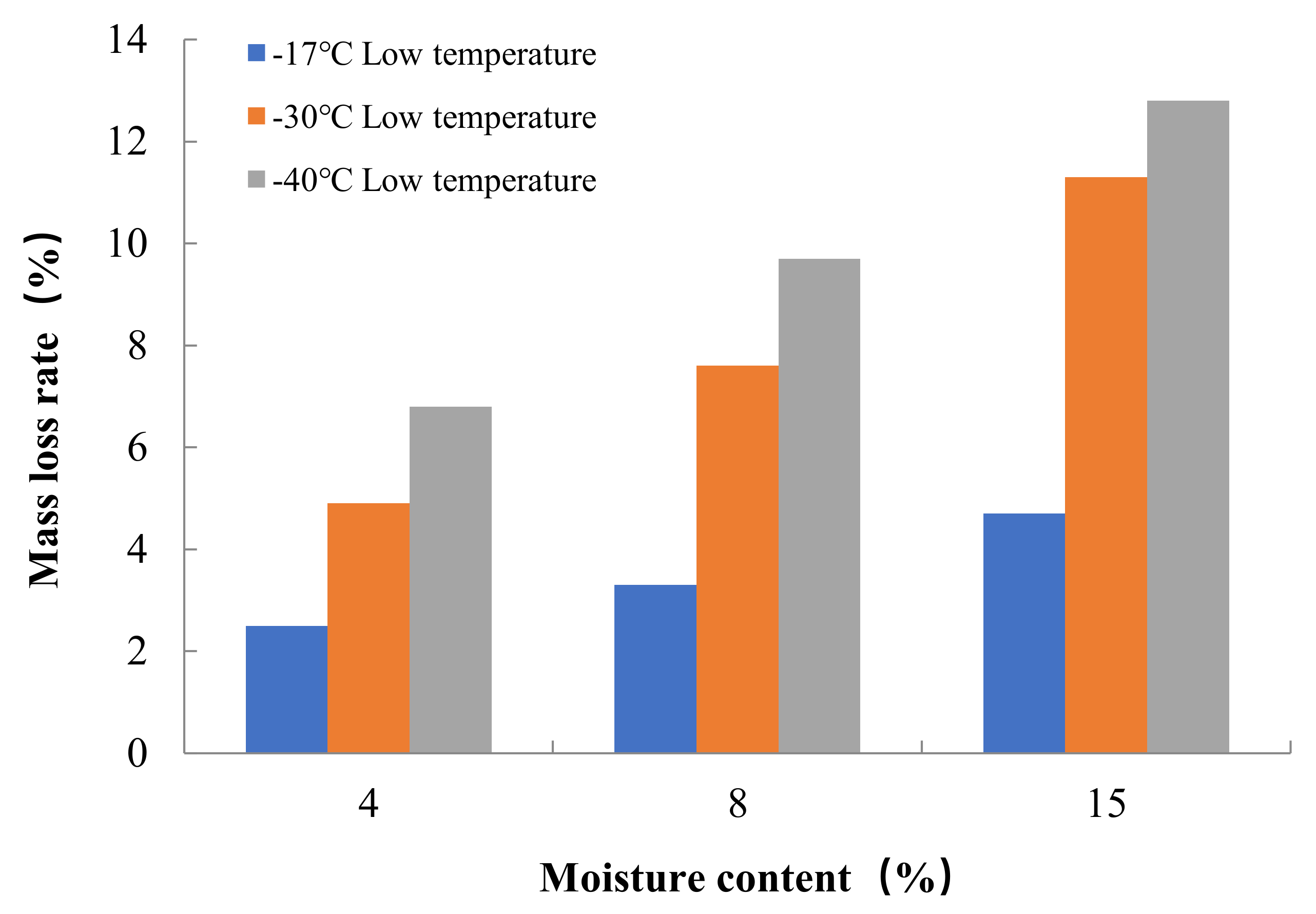
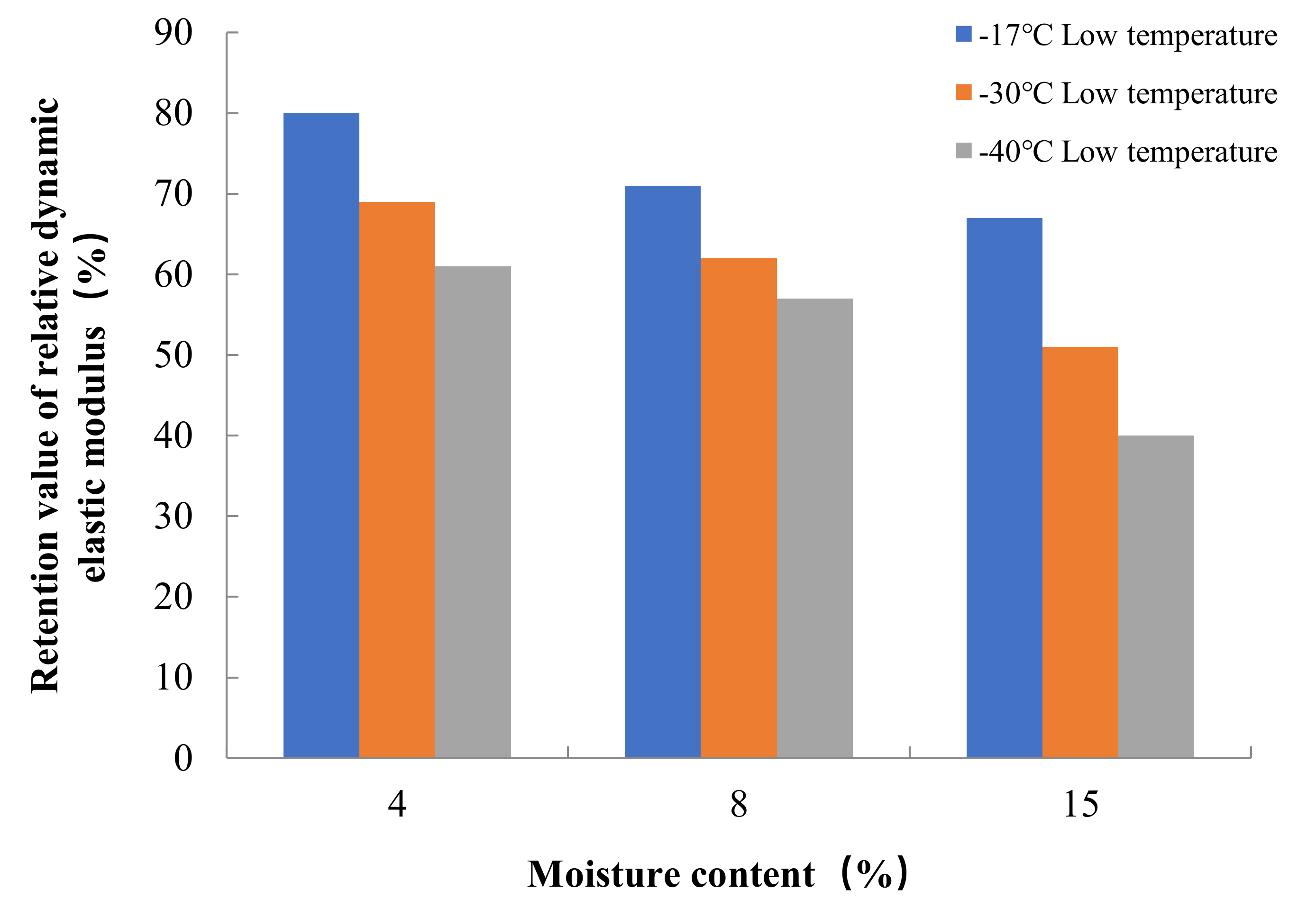
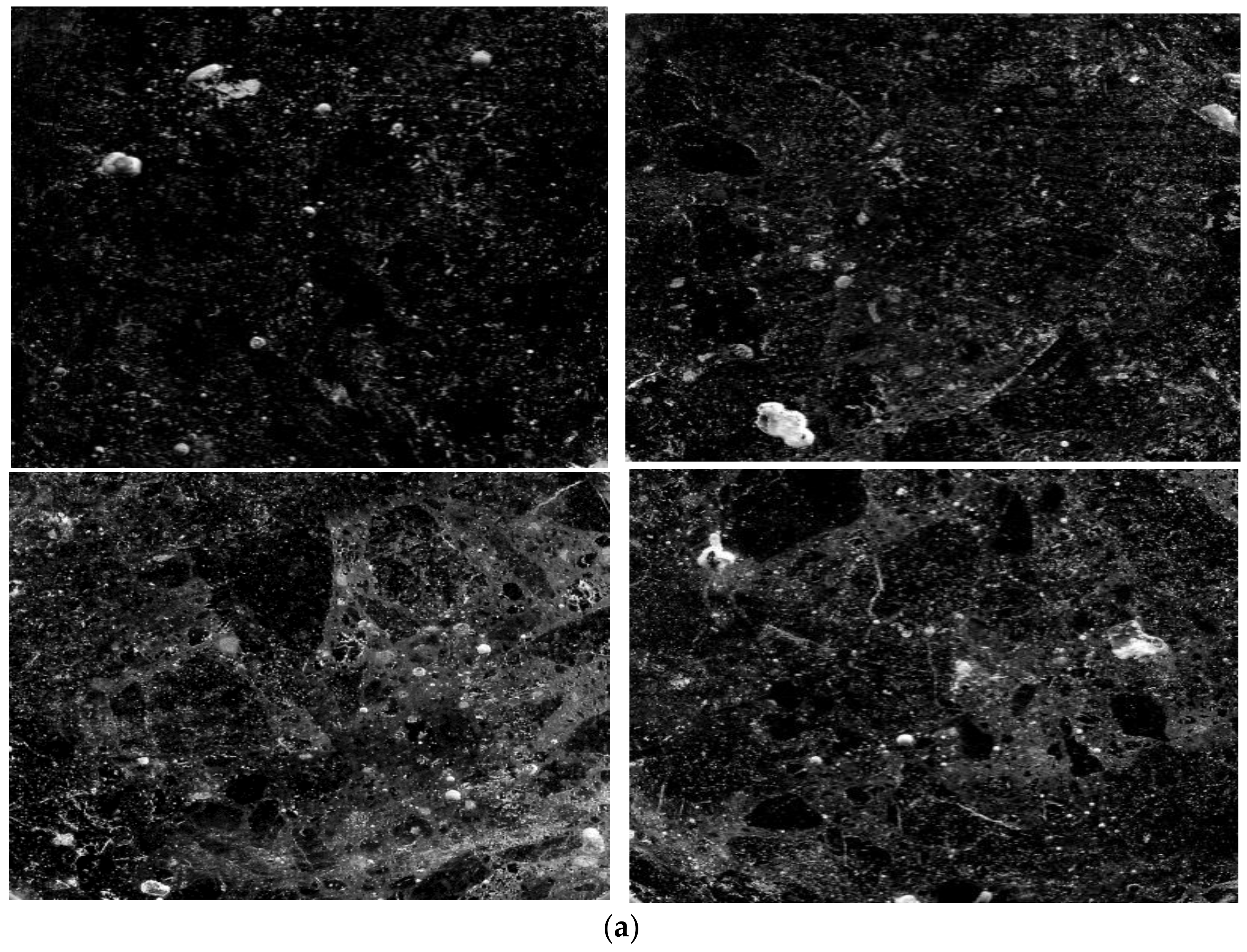
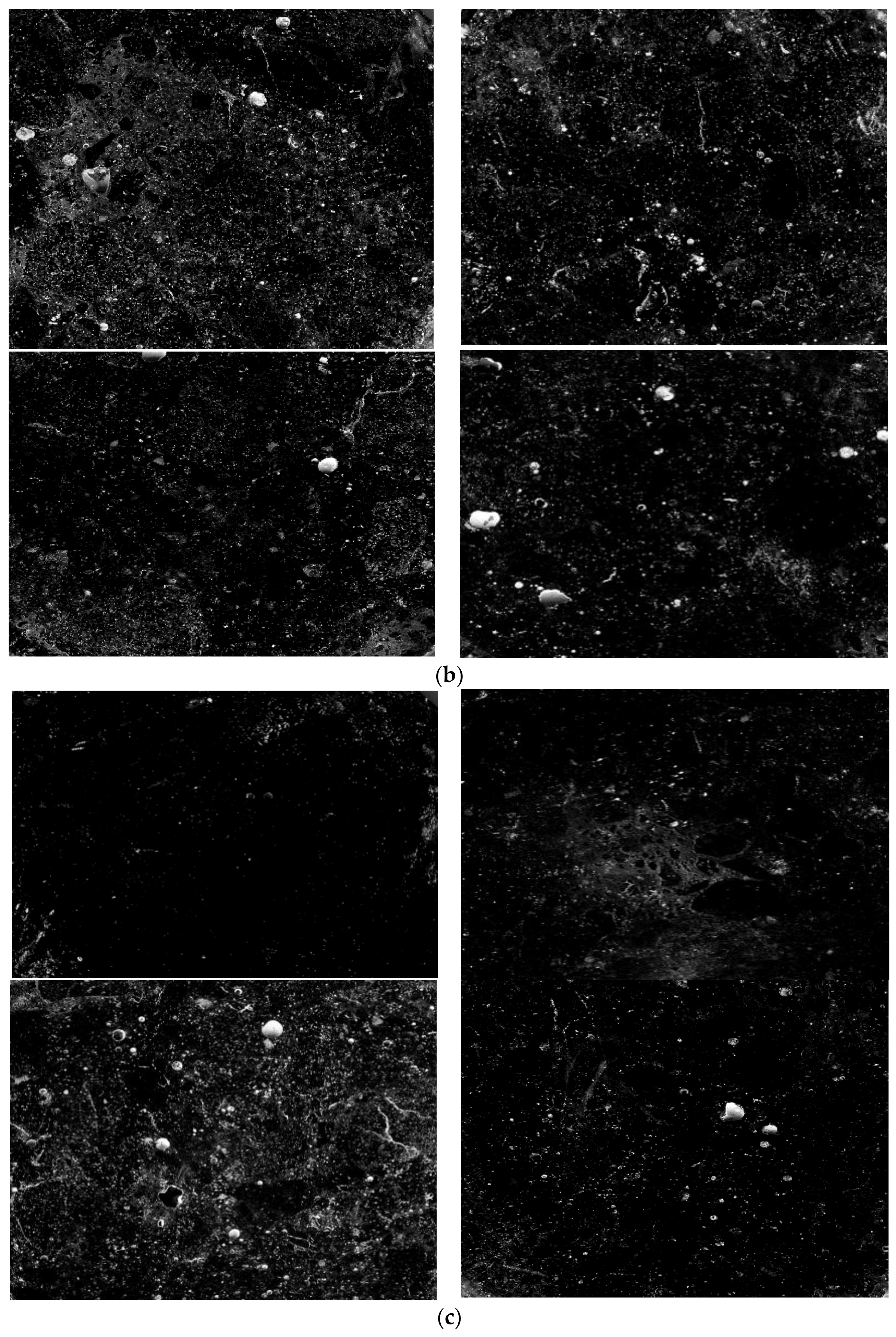
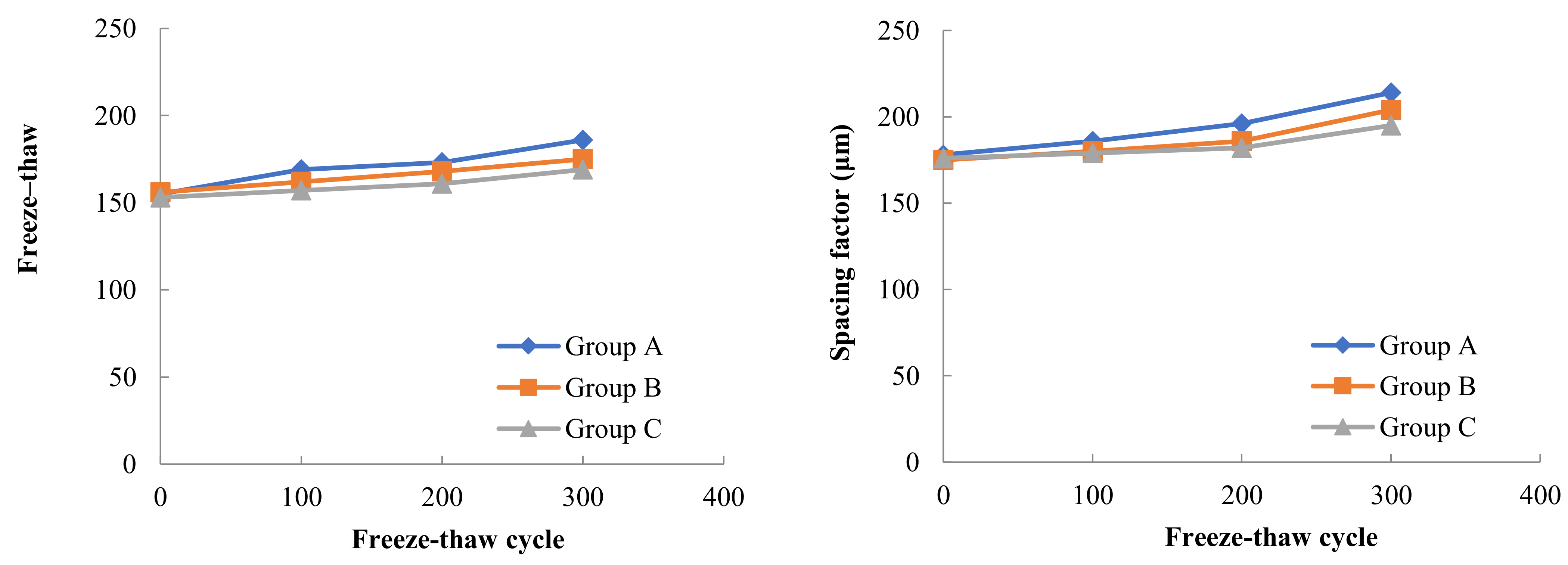
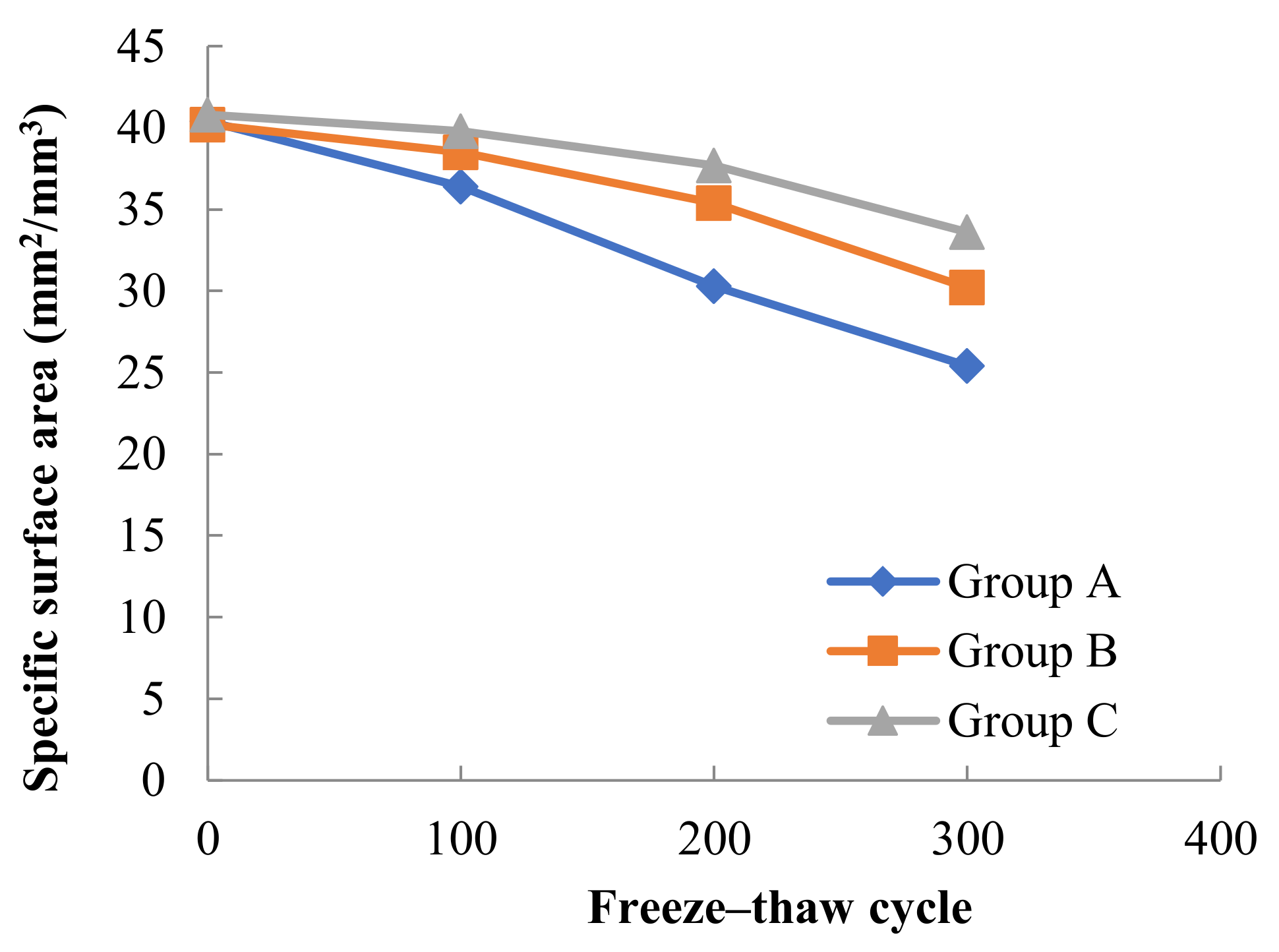
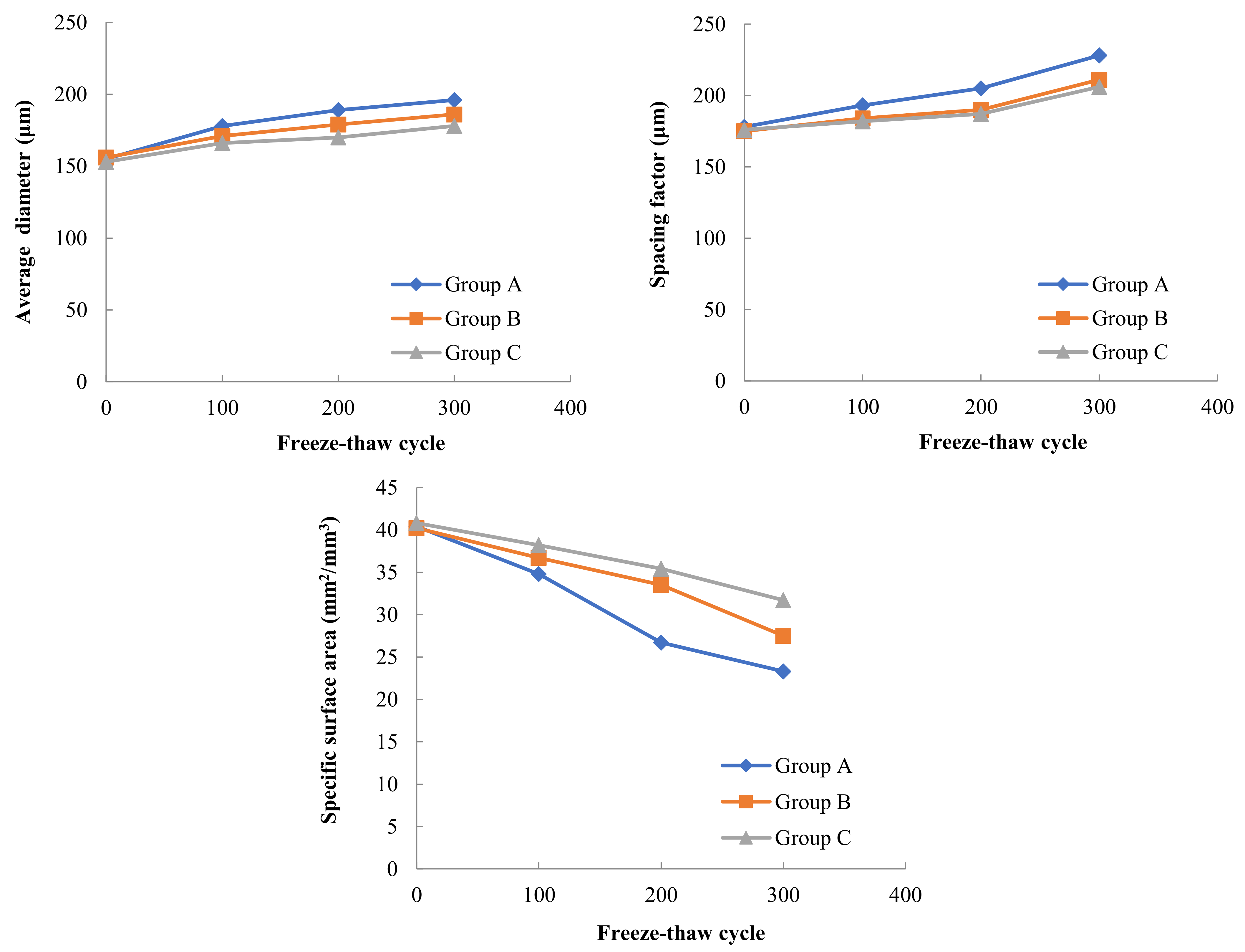
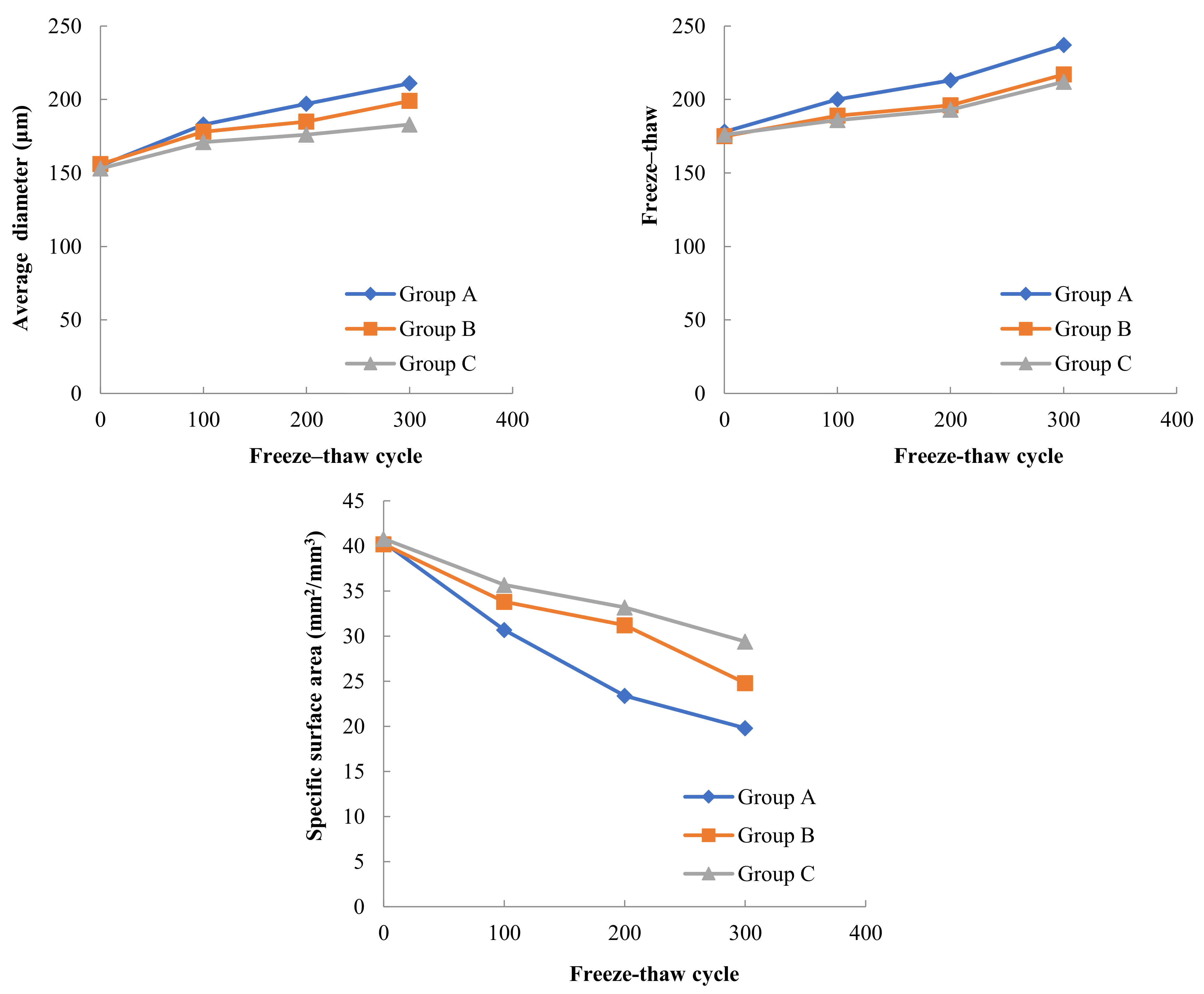
| Water Binder Ratio | Ordinary Portland Cement | Grade I Fly Ash | Natural Sand | Limestone Coarse Aggregate | Water-Reducing Agent (1/100) | Air-Entraining Agent (1/10,000) |
|---|---|---|---|---|---|---|
| 0.38 | 1 | 0.25 | 2.45 | 4.55 | 0.9 | 5.0 |
| Further Curing Condition | Sample Group | ||
|---|---|---|---|
| Temperature | Relative Humidity | Curing Time | |
| 20 °C | 90% | 24 h | Group A |
| 20 °C | 60% | 24 h | Group B |
| 60 °C | 60% | 24 h | Group C |
| Samples | Moisture Content (%) | Freeze Temperature (°C) | Average Diameter (μm) | Spacing Factor (μm) | Specific Surface Area (mm2/mm3) | |||||||||
|---|---|---|---|---|---|---|---|---|---|---|---|---|---|---|
| 0 | 100 | 200 | 300 | 0 | 100 | 200 | 300 | 0 | 100 | 200 | 300 | |||
| Group A | 15 | −17 | 155 | 169 | 173 | 186 | 178 | 186 | 196 | 214 | 40.4 | 36.4 | 30.3 | 25.4 |
| −30 | 178 | 189 | 196 | 193 | 205 | 228 | 34.8 | 26.7 | 23.3 | |||||
| −40 | 183 | 197 | 211 | 200 | 213 | 237 | 30.7 | 23.4 | 19.8 | |||||
| Group B | 8 | −17 | 156 | 162 | 168 | 175 | 175 | 180 | 186 | 204 | 40.2 | 38.5 | 35.4 | 30.2 |
| −30 | 171 | 179 | 186 | 184 | 190 | 211 | 36.7 | 33.5 | 27.5 | |||||
| −40 | 178 | 185 | 199 | 189 | 196 | 217 | 33.8 | 31.2 | 24.8 | |||||
| Group C | 4 | −17 | 153 | 157 | 161 | 169 | 176 | 179 | 182 | 195 | 40.8 | 39.8 | 37.7 | 33.6 |
| −30 | 166 | 170 | 178 | 182 | 187 | 206 | 38.2 | 35.4 | 31.7 | |||||
| −40 | 171 | 176 | 183 | 186 | 193 | 212 | 35.7 | 33.2 | 29.4 | |||||
Publisher’s Note: MDPI stays neutral with regard to jurisdictional claims in published maps and institutional affiliations. |
© 2022 by the authors. Licensee MDPI, Basel, Switzerland. This article is an open access article distributed under the terms and conditions of the Creative Commons Attribution (CC BY) license (https://creativecommons.org/licenses/by/4.0/).
Share and Cite
Ge, X.; Ke, M.; Liu, W.; Wang, H.; Lu, C.; Mei, G.; Yang, H. Effect of the Internal Humidity of Concrete on Frost Resistance and Air Void Structure under Different Low Temperature Conditions. Materials 2022, 15, 5225. https://doi.org/10.3390/ma15155225
Ge X, Ke M, Liu W, Wang H, Lu C, Mei G, Yang H. Effect of the Internal Humidity of Concrete on Frost Resistance and Air Void Structure under Different Low Temperature Conditions. Materials. 2022; 15(15):5225. https://doi.org/10.3390/ma15155225
Chicago/Turabian StyleGe, Xueliang, Mingyong Ke, Weibao Liu, Heng Wang, Cairong Lu, Guoxing Mei, and Hu Yang. 2022. "Effect of the Internal Humidity of Concrete on Frost Resistance and Air Void Structure under Different Low Temperature Conditions" Materials 15, no. 15: 5225. https://doi.org/10.3390/ma15155225
APA StyleGe, X., Ke, M., Liu, W., Wang, H., Lu, C., Mei, G., & Yang, H. (2022). Effect of the Internal Humidity of Concrete on Frost Resistance and Air Void Structure under Different Low Temperature Conditions. Materials, 15(15), 5225. https://doi.org/10.3390/ma15155225





